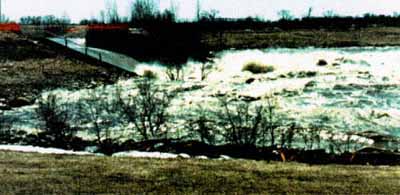Red River Floodway National Historic Site of Canada
Winnipeg, Manitoba

General view
(© Parks Canada Agency / Agence Parcs Canada, Richard Stuart, 1997.)
Address :
Winnipeg, Manitoba
Recognition Statute:
Historic Sites and Monuments Act (R.S.C., 1985, c. H-4)
Designation Date:
2000-11-15
Dates:
-
1962 to 1968
(Construction)
-
1997 to 1997
(Significant)
Event, Person, Organization:
-
H.G. Acres and Company Ltd.
(Architect)
-
Department of Agriculture and Conservation, Water Control and Conservation Branch, Manitoba
(Architect)
-
Horton Steel Works Ltd.
(Builder)
-
Northern Construction Company
(Builder)
-
J.W. Steward Ltd.
(Builder)
-
Bird Construction Ltd.
(Builder)
Other Name(s):
-
Red River Floodway
(Designation Name)
-
Duff's Ditch
(Other Name)
Research Report Number:
2000-005
Plaque(s)
Approved Inscription: Winnipeg, Manitoba
An outstanding engineering achievement on a grand scale, the Red River Floodway has protected Winnipeg from several potentially devastating floods. Affectionately dubbed Duffs Ditch, in honour of then-Premier Duff Roblin, this 47-km long channel and component control structures were built between 1962 and 1968 to divert floodwaters around the city. The floodway proved its worth during the Flood of the Century in 1997. It has become an inspirational symbol to Canadians in the ongoing struggle to control the powerful forces of nature.
Description of Historic Place
The Red River Floodway National Historic Site of Canada is part of a massive flood control system that lies east of Winnipeg, Manitoba. The city itself is located on a flood plain at the confluence of the Red and Assiniboine Rivers, on one of the flattest areas in North America. Engineered between 1962 and 1968 to protect Winnipeg from threat of flooding by the Red River, the floodway detours excess waters harmlessly eastwards around the city, where it rejoins the river further downstream. The designation refers to the footprints of the Inlet Control Structure, the Floodway Channel, and the Outlet Control Structure.
Heritage Value
The Red River floodway was designated a national historic site of Canada in 2000 because: it is an outstanding engineering achievement in function and impact of the engineered flood control system in the development of a major Canadian city; it is of exceptional symbolic importance to Canadians; the system, on the basis of the efficacy of its design and its capacity to handle floodwaters in excess of its design flood function, has had, and will continue to have a socio-economic impact of both provincial and national significance.
The Red River has flooded many times in documented history, often with disastrous consequences to nearby settlements. Known affectionately as “Duff’s Ditch” after its advocate, former Manitoba Premier Duff Roblin, the floodway became the largest component in a comprehensive engineering project launched by the Government of Manitoba in the 1960s to protect its inhabitants. The Red River Floodway was built in response to the catastrophic destruction of the 1950 flood in Manitoba, which flooded almost one-tenth of the city.
Plans for the intake and outlet devices were drawn up by H.G. Acres & Company Ltd., Consulting Engineers of Niagara Falls, in conjunction with the Red River Floodway Advisory Board of Manitoba’s Water Control and Conservation Branch. As the largest excavation project undertaken in Canada to date, construction was shared between the Northern Construction Co. and J.W. Steward Ltd., both of Vancouver, and Winnipeg’s Bird Construction Ltd. and Horton Steel Works of Toronto which fabricated the sector gates and hydraulic operating pistons.
Impressive in scale and design, it is the great efficacy of the Red River Floodway as an engineering achievement that defines its value. Using available technology of hydraulics and a massive earthwork, its designers were able to divert the natural, destructive force of the Red River, thereby allowing the city of Winnipeg to grow and develop, secure from the unpredictable threat of flooding. The gates of the Intake Control Structures, which are located south of the city, control the floodwaters from upriver and the 47-kilometre long floodway channel detours excess water harmlessly eastwards around the city. Through the exit spillway of the Outlet Control Structure north of the city, floodwaters then rejoin the Red River as it nears its delta.
While extreme floods likes those in 1950 and 1997 are rare, the Red River Floodway has been put into operation many times since its completion, diverting floodwaters and preventing inundation to save Winnipeg homes and businesses from extensive flood damages.
Source: Historic Sites Monuments Board of Canada, Minutes, June 2000.
Character-Defining Elements
Key elements contributing to the heritage value of the Red River Floodway include: its location to the east of the City of Winnipeg; the relationship between the floodway and the growth and development of a major Canadian metropolis.
Key elements contributing to the heritage value of the Inlet Control Structure include: its location a short distance downstream of the entrance to the floodway channel south of Winnipeg; its function of diverting excess water into the floodway channel; its reinforced concrete structure, including a central control tower; two underwater steel gates set on hydraulic pistons that can be moved to restrict the water flow.
Key elements contributing to the heritage value of the Floodway Channel, include: its 47-kilometre semi-circular shape, engineered to reflect the natural drop of the river, and diked along its length to increase capacity; its 275-metre wide underwater Inlet Lip, also referred to as a “plug” of clay, which crosses the floor of the floodway channel to prevent ice floes from entering the floodway; the efficiency of its design, allowing for crop-growing on its embankments.
Key elements contributing to the heritage value of the Outlet Control Structure, include: its location at the foot of the floodway channel at its junction with the Red River downstream of Winnipeg; its concrete drop structure that incorporates a rollway and stilling basin, which control the release of the diverted floodwaters.